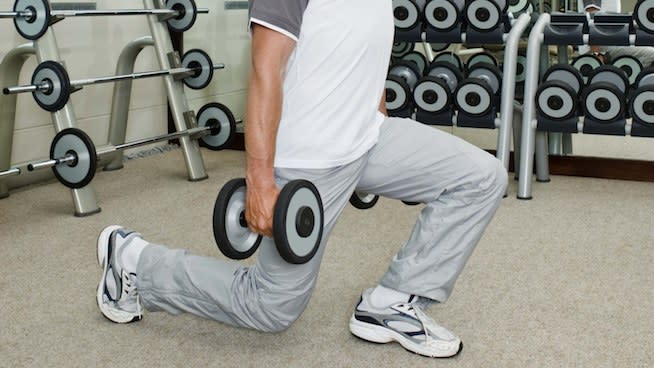What Is the Best Lunge Variation?

The Lunge is often performed by athletes and gym-goers alike. The exercise builds lower-body strength, improves knee stability and even fixes fundamental movement and posture problems. But not all Lunges are created equal.
We spoke with Tony Bonvechio, STACK Expert and owner of Bonvec Strength, to break down the benefits of three common Lunge variations so you can determine how each might fit into your training program.
Lunge Variations
Forward Lunge
Any athlete who changes directions will benefit from the Forward Lunge. It teaches you to decelerate and control your body as you lower into the move, just like when you slow down to make a cut. It’s also a great quad developer, particularly building VMO (the inside part of your quadriceps muscles). If you build this muscle, you will get faster.
Common Mistakes and Fixes
Mistake 1: Your front knee drifts too far forward beyond your toes, which may cause knee pain.
Fix: Take a bigger step forward, so your knee does not pass your toes. A vertical shin is not necessary, although the exercise is commonly coached this way.
Mistake 2: Allowing your front knee to drift inward, which reinforces poor mechanics—one of the primary causes of ACL injuries.
Fix: Keep your knee in line with your hip and ankle. If this is difficult, try strengthening your abductors.
Mistake 3: Blasting off your front leg, leading with your toes.
Fix: Keep your ankle dorsiflexed (i.e., foot flexed toward shin) and drive through your heel.
Walking Forward Lunge
This is a variation of the Forward Lunge in which you continue walking forward instead of driving back off your front leg. It is best used for conditioning and mobility rather than as a muscle and strength builder. Think of it similar to an Overhead Squat; it’s a better display of mobility and coordination than pure strength. This is a great option to include in your warm-up.
Common Mistakes and Fixes
Mistake 1: Your front knee drifts too far forward beyond your toes, which may cause knee pain.
Fix: Take a bigger step forward, so your knee does not pass your toes. A vertical shin is not necessary, although the exercise is commonly coached this way.
Mistake 2: Allowing your front knee to drift inward, which reinforces poor mechanics—one of the primary causes of ACL injuries.
Fix: Keep your knee in line with your hip and ankle. If this is difficult, try strengthening your abductors.
Mistake 3: Disengaging your abs and allowing your back to arch, which can cause back problems.
Fix: Keep your abs tight and torso upright. You want to keep your chest up, but you should never lean back.
Reverse Lunge
The Reverse Lunge is the best option if you want to use heavy weight, especially for new lifters. You are able to control your tibia (i.e., your shin) and knee, and it doesn’t require as much ankle mobility. It’s also easier to drive off the heel of your front leg, similar to a Deadlift or Squat, so you can perform the move explosively. There’s also less of a deceleration component. If you can perform this variation with weight proficiently, there’s a good chance you’ll have good technique on the Forward Lunge.
Common Mistakes and Fixes
Mistake 1: Your front knee drifts too far forward beyond your toes, which may cause knee pain.
Fix: Take a bigger step backward, so your knee does not pass your toes. A vertical shin is not necessary, although the exercise is commonly coached this way.
Mistake 2: Allowing your front knee to drift inward, which reinforces poor mechanics—one of the primary causes of ACL injuries.
Fix: Keep your knee in line with your hip and ankle. If this is difficult, try strengthening your abductors.
Mistake 3: Pushing off your back leg to stand up.
Fix: Drive through your front heel. Your back leg should come along for the ride.
Weight Options
You can perform the three variations above with several different pieces of equipment. Here are three options Bonvechio recommends:
With dumbbells at your sides: This is a good option for anyone with bad posture, because it pulls you out of that position. However, if you already have a posture where your shoulders are down and back, then the dumbbells may pull your back into extension, creating potential back problems.
Using a goblet hold: Holding a dumbbell or kettlebell against your chest engages the front side of your core and keeps your back neutral, making it the easiest method for maintaining perfect form. It’s also less grip-intensive, which can be problematic if you perform Lunges after moves such as Deadlifts or Pull-Ups. The main drawback is you can’t load it up very heavy. If you can do Goblet Lunges with a 100-pound dumbbell, you’re probably pretty strong, but you won’t be able to do much more.
With a barbell: The barbell allows you to use heavy loads, which is this option's main advantage. But, it’s much harder to control. Often you need to compromise your position to simply hold the bar. If someone has lousy rotation in their shoulders, form becomes an issue.
RELATED: 4 Exercises to Fix Bad Posture and Help You Move Better
This article originally appeared on STACK.com: What Is the Best Lunge Variation?

